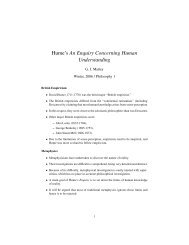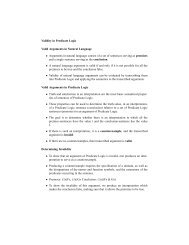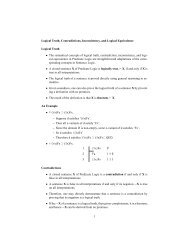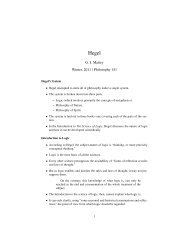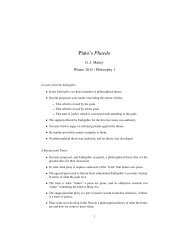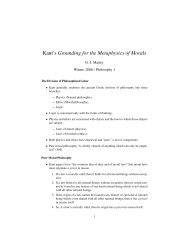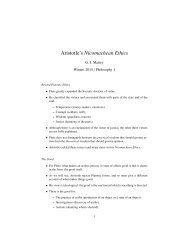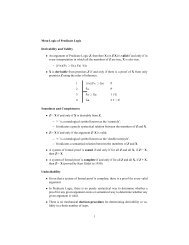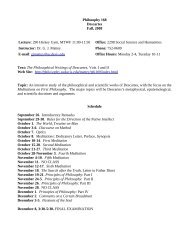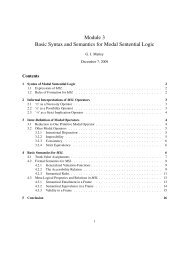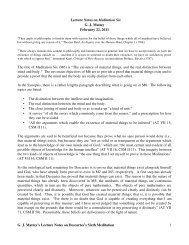Kant's Critique of Pure Reason - the UC Davis Philosophy Department
Kant's Critique of Pure Reason - the UC Davis Philosophy Department
Kant's Critique of Pure Reason - the UC Davis Philosophy Department
You also want an ePaper? Increase the reach of your titles
YUMPU automatically turns print PDFs into web optimized ePapers that Google loves.
Kant’s <strong>Critique</strong> <strong>of</strong> <strong>Pure</strong> <strong>Reason</strong><br />
G. J. Mattey<br />
Winter, 2006 / <strong>Philosophy</strong> 1<br />
Metaphysics in Disarray<br />
• Immanuel Kant (1724-1804) in his early career worked in <strong>the</strong> tradition <strong>of</strong> continental<br />
rationalism.<br />
• He wrote that his recollection <strong>of</strong> David Hume awoke him from his “dogmatic<br />
slumber.”<br />
• He recognized that metaphysics had not been established as a science, and in fact<br />
had made little progress since ancient times.<br />
• Philosophers had reached impasses on all <strong>the</strong> main metaphysical questions.<br />
• This is a disastrous result, because metaphysics is supposed to be <strong>the</strong> “queen <strong>of</strong><br />
<strong>the</strong> sciences.”<br />
• Kant set out to place metaphysics on a new footing by subjecting <strong>the</strong> use <strong>of</strong> “pure<br />
reason” to a scathing “critique.”<br />
Our Interest in Metaphysics<br />
• Apart from its alleged role as <strong>the</strong> basis <strong>of</strong> all science, metaphysics is intended to<br />
satisfy three fundamental interests <strong>of</strong> human beings:<br />
– Does God exist?<br />
– Am I free in my actions?<br />
– Will I survive my death?<br />
• The answers to <strong>the</strong>se three questions are supposed to be found in three branches<br />
<strong>of</strong> metaphysics:<br />
– Theology,<br />
– Cosmology,<br />
– Psychology.<br />
• Kant’s realization was that we have no right to proceed with any <strong>of</strong> <strong>the</strong>se metaphysical<br />
investigations until we have answered this question:<br />
– How is metaphysics itself possible as a science?<br />
1
Rationalist Metaphysics<br />
• On Kant’s view, a minimal condition for a metaphysical system is that it contain<br />
only necessary truths.<br />
• Hume had proved that probable reasoning from experience cannot reveal <strong>the</strong> way<br />
things must be.<br />
• So, an acceptable metaphysical system must be based on <strong>the</strong> a priori use <strong>of</strong><br />
reason.<br />
• Continental rationalists writing after Descartes had proposed various metaphysical<br />
systems that are not based on experience.<br />
• The system within which Kant worked in his early years was a modification <strong>of</strong><br />
system proposed by Leibniz (1646-1716).<br />
Leibniz’s Metaphysical System<br />
• According to Leibniz, <strong>the</strong>re are two fundamental principles which are known a<br />
priori through reason.<br />
– The principle <strong>of</strong> non-contradiction (PNC): if <strong>the</strong> notion <strong>of</strong> a thing is selfcontradictory,<br />
<strong>the</strong>n it is impossible.<br />
∗ “Square circle” is a contradictory notion, and so it is impossible that<br />
<strong>the</strong>re be a square circle.<br />
– The principle <strong>of</strong> sufficient reason (PSR): if a thing exists, <strong>the</strong>n it does so in<br />
virtue <strong>of</strong> a reason sufficient to bring about its existence.<br />
∗ If a stone becomes warm, <strong>the</strong>n <strong>the</strong>re is a reason for its becoming warm<br />
(such as being heated by <strong>the</strong> sun).<br />
• Leibniz held that <strong>the</strong> principle <strong>of</strong> non-contradiction is enough to establish what<br />
is possible, and <strong>the</strong> principle <strong>of</strong> sufficient reason is enough to establish what is<br />
actual.<br />
• Theoretically, it can be known a priori what is possible and what is actual<br />
(though perhaps only by God, and not by humans).<br />
Hume’s Problem Applied to Leibniz’s System<br />
• Kant recognized that Hume had raised a fundamental problem for any rationalist<br />
metaphysics that employs <strong>the</strong> principle <strong>of</strong> sufficient reason.<br />
• How is <strong>the</strong> PSR supposed to be justified a priori?<br />
• It would have to be based on demonstrative reasoning, and its denial would have<br />
to be contradictory.<br />
2
• But what contradiction is <strong>the</strong>re in <strong>the</strong> proposition that something exists without<br />
a reason sufficient to bring its existence about?<br />
• Kant agrees with Hume that none can be found.<br />
• If this is correct, and if <strong>the</strong> PSR is fundamental to any metaphysical system,<br />
<strong>the</strong>n <strong>the</strong> practice <strong>of</strong> metaphysics must be halted until <strong>the</strong> PSR can be given an<br />
adequate justification.<br />
• This is one <strong>of</strong> <strong>the</strong> main tasks <strong>of</strong> <strong>the</strong> <strong>Critique</strong> <strong>of</strong> <strong>Pure</strong> <strong>Reason</strong>.<br />
The Antinomy <strong>of</strong> <strong>Pure</strong> <strong>Reason</strong><br />
• A second problem with metaphysics lies in <strong>the</strong> application <strong>of</strong> <strong>the</strong> PSR to cases.<br />
• Kant tried to show that an unrestricted application <strong>of</strong> <strong>the</strong> PSR will yield contradictory<br />
results, which he called <strong>the</strong> “antinomy <strong>of</strong> pure reason.”<br />
• Take <strong>the</strong> question <strong>of</strong> free (uncaused) human action as an example.<br />
• It can be “proved” that <strong>the</strong>re are free human actions.<br />
– If <strong>the</strong>re are no uncaused human actions, <strong>the</strong>n <strong>the</strong> chain <strong>of</strong> causes resulting<br />
in a given human action is infinite.<br />
– If a chain <strong>of</strong> causes leading to x is infinite, <strong>the</strong>n <strong>the</strong>re is no sufficient reason<br />
for x.<br />
• And it can be “proved” that <strong>the</strong>re are no free human actions.<br />
– If <strong>the</strong>re is an uncaused human action, <strong>the</strong>n <strong>the</strong>re is no cause to serve as a<br />
sufficient reason for that action.<br />
• Similar contradictions can be generated for o<strong>the</strong>r metaphysical propositions.<br />
A New Method for Metaphysics<br />
• Given Hume’s results and <strong>the</strong> antinomy, Kant’s task was tw<strong>of</strong>old:<br />
– To provide an a priori justification for <strong>the</strong> principle <strong>of</strong> sufficient reason<br />
(and perhaps o<strong>the</strong>r metaphysical principles),<br />
– To do so in a way that avoids contradiction.<br />
• As an aid to accomplishing this task, Kant turned to <strong>the</strong> sciences which, unlike<br />
metaphysics, had a record <strong>of</strong> success:<br />
– Ma<strong>the</strong>matics,<br />
– Natural Science.<br />
• He thought that a method shared by ma<strong>the</strong>matics and natural science can be<br />
adapted to metaphysics.<br />
3
Scientific Method<br />
• Kant considered geometrical pro<strong>of</strong> to be a paradigm <strong>of</strong> ma<strong>the</strong>matical practice.<br />
• Geometrical objects, he claimed, are not given to us, but are only constructed.<br />
– A line is constructed from points, surfaces from lines, and solids from surfaces.<br />
• The properties <strong>of</strong> a geometrical object, such as a square, depend on <strong>the</strong> way in<br />
which a square would be constructed from lines.<br />
• The square’s properties <strong>of</strong> are, so <strong>the</strong> speak, “built into” it through <strong>the</strong> manner <strong>of</strong><br />
its construction.<br />
• In natural science, we perform experiments by constructing experimental set-ups<br />
with <strong>the</strong> properties we want.<br />
• The results <strong>of</strong> <strong>the</strong> experiment depend to that extent on what has been “built into”<br />
<strong>the</strong> experimental set-up.<br />
Applying Scientific Method to Metaphysics<br />
• Geometry and natural science have in common <strong>the</strong> following feature:<br />
– They do not begin with <strong>the</strong>ir objects and try to determine <strong>the</strong>ir properties,<br />
but ra<strong>the</strong>r,<br />
– They construct <strong>the</strong>ir objects and discover <strong>the</strong> consequences <strong>of</strong> <strong>the</strong> construction.<br />
• Metaphysics traditionally has followed <strong>the</strong> first <strong>of</strong> <strong>the</strong> above procedures.<br />
• It begins with pure concepts, which have been generated by pure reason, and<br />
<strong>the</strong>n tries to discover whe<strong>the</strong>r reality conforms to those concepts.<br />
– We have a concept <strong>of</strong> a most real being, which we call God,<br />
– Does God exist?<br />
• The proper method is to begin with a construction <strong>of</strong> reality and <strong>the</strong>n discover<br />
which concepts are required to carry out <strong>the</strong> construction.<br />
Constructing Reality?<br />
• Kant’s suggestion that metaphysical investigation should imitate scientific investigation<br />
has led to a startling consequence.<br />
• It may be correct to say that geometrical objects are constructed, in that <strong>the</strong>y are<br />
ideal.<br />
4
• And it may be correct to say that experimental set-ups are constructed from<br />
things that already exist.<br />
• But it is going pretty far to say that <strong>the</strong> objects <strong>of</strong> metaphysics, i.e., all really<br />
existing things, are <strong>the</strong>mselves constructed.<br />
• A main problem in Kant interpretation is to determine whe<strong>the</strong>r Kant really made<br />
this extraordinary claim.<br />
• Note that it is almost commonplace in present-day thinking to make a claim<br />
similar to this.<br />
• So Kant had a great influence on <strong>the</strong> way many people now think, regardless <strong>of</strong><br />
what he intended to claim.<br />
Two Interpretations <strong>of</strong> Kant<br />
• The view that human beings construct reality is extreme, and controversial.<br />
• A weaker view is that we human beings only construct <strong>the</strong> way in which we must<br />
represent reality.<br />
• The point <strong>of</strong> both approaches is to enable us to reflect <strong>the</strong> goal <strong>of</strong> metaphysics.<br />
– Suppose that metaphysics is <strong>the</strong> description <strong>of</strong> <strong>the</strong> most fundamental aspects<br />
<strong>of</strong> reality.<br />
• The stronger view more clearly reflects this goal <strong>of</strong> metaphysics, but it seems<br />
intrinsically implausible.<br />
• The milder view seems intrinsically more plausible, but it it does not clearly<br />
reflect this goal <strong>of</strong> metaphysics.<br />
Two Ways <strong>of</strong> Thinking About Reality<br />
• For Kant, <strong>the</strong> goal <strong>of</strong> metaphysics is to construct, a priori, a system <strong>of</strong> concepts<br />
and principles.<br />
• In that case, we can ask whe<strong>the</strong>r <strong>the</strong> a priori metaphysical system applies to<br />
reality, or merely to <strong>the</strong> way we think about reality.<br />
• Kant’s answer would be that <strong>the</strong>re are two distinct ways <strong>of</strong> describing something<br />
as real:<br />
– As empirically real, i.e., as object <strong>of</strong> experience, or “appearance,”<br />
– As transcendentally real, as an object independent <strong>of</strong> experience, or “thing<br />
in itself.”<br />
• Kant claims that <strong>the</strong> a priori system <strong>of</strong> metaphysics holds only for what is real<br />
empirically.<br />
5
• The mistake <strong>of</strong> metaphysics has been to try to construct a priori a system that<br />
applies to things in <strong>the</strong>mselves.<br />
• This seems to require that <strong>the</strong> empirically real be constructed according to <strong>the</strong><br />
rules <strong>of</strong> <strong>the</strong> system.<br />
Duplicating <strong>the</strong> Original Problem<br />
• Now we must ask again our original question, which was directed at “reality” as<br />
such.<br />
• Do we construct objects that are empirically real?<br />
• Empirically real objects are objects in space and time, so does Kant adopt <strong>the</strong><br />
strong view that spatio-temporal objects are constructions <strong>of</strong> <strong>the</strong> human mind?<br />
• Or should we adopt <strong>the</strong> weaker view that as humans we only construct a way <strong>of</strong><br />
representing objects in space and time?<br />
• Unfortunately, Kant’s text supports both interpretations.<br />
The Outputs <strong>of</strong> Human Mental Activity<br />
• The structure <strong>of</strong> Kant’s metaphysical system reflects <strong>the</strong> different kinds <strong>of</strong> outputs<br />
<strong>of</strong> human mental activity.<br />
– Intuitions, which present individual objects,<br />
– Concepts, which present many objects as falling under kinds,<br />
– Judgments, which combine intuitions, concepts, and judgments <strong>the</strong>mselves<br />
into descriptions <strong>of</strong> reality.<br />
• For example, Socrates meets Plato and is “presented” to Plato through an intuition.<br />
• Plato has <strong>the</strong> concepts <strong>of</strong> a philosopher and <strong>of</strong> wisdom, which apply to more than<br />
one individual.<br />
– Plato forms <strong>the</strong> judgment that Socrates is a philosopher.<br />
– Plato also forms <strong>the</strong> judgment that all philosophers are wise.<br />
– Plato infers from this that Socrates is wise.<br />
Analytic and Syn<strong>the</strong>tic Judgments<br />
• Kant divides all judgments into two types:<br />
– Analytic judgments, which only serve to clarify concepts:<br />
∗ A square is a plane figure with four equal sides.<br />
6
– Syn<strong>the</strong>tic judgments, which connect a concept with something beyond it:<br />
∗ The sum <strong>of</strong> <strong>the</strong> angles <strong>of</strong> a square is 360 o .<br />
∗ The sun warms <strong>the</strong> stone.<br />
• A system <strong>of</strong> metaphysics will consist primarily <strong>of</strong> syn<strong>the</strong>tic judgments which are<br />
made a priori.<br />
• Kant insists that before such a system is developed, it must be shown how syn<strong>the</strong>tic<br />
judgments can be made a priori.<br />
• Roughly, <strong>the</strong> answer is that because we construct <strong>the</strong> objects about which <strong>the</strong><br />
judgment is made, we can know in advance <strong>of</strong> experience that <strong>the</strong> object has <strong>the</strong><br />
features attributed to it in <strong>the</strong> judgment.<br />
Intellectual Intuition<br />
• The standard rationalist answer to Kant’s question about <strong>the</strong> a priori origin <strong>of</strong><br />
syn<strong>the</strong>tic judgments is that <strong>the</strong>y are known through “intellectual intuition.”<br />
• The truth <strong>of</strong> <strong>the</strong> proposition is immediately known to reason.<br />
– For example, Descartes claimed that we can know a (syn<strong>the</strong>tic) causal principle<br />
by <strong>the</strong> “light <strong>of</strong> nature.”<br />
• On Kant’s view intuition is a power through which objects are given to <strong>the</strong> mind.<br />
• An intellectual intuition would be one in which objects are given to our rational<br />
faculty simply by thinking about <strong>the</strong>m.<br />
• But, Kant claims, no objects are given to <strong>the</strong> rational faculty only by thinking<br />
about <strong>the</strong>m.<br />
– Humans only intuit objects in sense-perception.<br />
– Thinking takes place through <strong>the</strong> use <strong>of</strong> abstract concepts.<br />
• So, <strong>the</strong>re is no human knowledge through intellectual intuition.<br />
• If we are to have a purely rational knowledge <strong>of</strong> a principle, it would be through<br />
<strong>the</strong> relation <strong>of</strong> concepts to one ano<strong>the</strong>r, and hence analytic.<br />
Sensible Intuition<br />
• Kant came to <strong>the</strong> surprising conclusion that we can gain knowledge a priori<br />
<strong>of</strong> syn<strong>the</strong>tic propositions through <strong>the</strong> passive reception <strong>of</strong> objects presented in<br />
sense-perception.<br />
• This conclusion is contrary to <strong>the</strong> views <strong>of</strong> both <strong>the</strong> rationalists and <strong>the</strong> empiricists.<br />
– The rationalists held that no real knowledge is gained through sense-perception,<br />
7
– The empiricists held that all knowledge through sense-perception is a posteriori,<br />
or experiential.<br />
• The key to this view is that sensation gives us <strong>the</strong> matter <strong>of</strong> intuited objects, <strong>the</strong><br />
faculty <strong>of</strong> “sensibility” gives us <strong>the</strong> form <strong>of</strong> <strong>the</strong> objects.<br />
• There are two forms <strong>of</strong> human sensibility:<br />
– Space,<br />
– Time.<br />
• Kant’s view, <strong>the</strong>n, is that all objects which are intuited in sense-perception are in<br />
space and time.<br />
A Priori Knowledge <strong>of</strong> <strong>the</strong> Quantifiable Properties <strong>of</strong> Intuited Objects<br />
• As was stated earlier, Kant claimed that <strong>the</strong> objects <strong>of</strong> geometry are constructed<br />
by <strong>the</strong> human mind.<br />
• He also claimed that numbers are generated by counting.<br />
• These two claims can be connected with space and time.<br />
– Geometrical objects are constructed in space,<br />
– Numbers are constructed in time.<br />
• Given that intuited objects are in space and time, geometrical and numerical<br />
constructions apply to <strong>the</strong>m.<br />
• Ma<strong>the</strong>matical constructions in general can be carried out a priori.<br />
• We can thus know, a priori, that intuited objects have quantitative properties to<br />
which ma<strong>the</strong>matics applies.<br />
• This result provides a foundation for ma<strong>the</strong>matical sciences <strong>of</strong> sensibly intuited<br />
objects.<br />
The Categories <strong>of</strong> <strong>the</strong> Understanding<br />
• Space and time are a priori forms to which every object given in sensible intuition<br />
must conform.<br />
• Corresponding to space and time are a priori concepts <strong>of</strong> <strong>the</strong> understanding, <strong>the</strong><br />
categories.<br />
• Categories are supposed to be based on logical forms <strong>of</strong> judgment.<br />
• One important category is that <strong>of</strong> substance and accident.<br />
– Logical form <strong>of</strong> judgment: object O has predicate F.<br />
8
– Category: O is a substance, which has properties but is not a property <strong>of</strong><br />
something else.<br />
• A second important category is that <strong>of</strong> cause and effect.<br />
– Logical form <strong>of</strong> judgment: if O is F, <strong>the</strong>n O is G.<br />
– Category: given that O has a property at a time, O is lawfully determined<br />
to have some o<strong>the</strong>r property at a later time.<br />
The Category <strong>of</strong> Substance and Accident<br />
• According to Kant, concepts are intellectual rules for describing sensibly intuited<br />
objects.<br />
• The category <strong>of</strong> substance is a rule describing how objects endure and how <strong>the</strong>y<br />
change.<br />
• Kant tries to prove that intuited objects are substances.<br />
• He claims that substances are permanent, i.e., that <strong>the</strong>y do not come into existence<br />
or go out <strong>of</strong> existence.<br />
• So, <strong>the</strong> only way in which intuited objects change is by having different “accidents.”<br />
The Category <strong>of</strong> Cause and Effect<br />
• As substances, intuited objects are subject to changes in <strong>the</strong>ir states over time.<br />
• The category <strong>of</strong> cause and effect represents change as taking place as governed<br />
by a rule which must be followed.<br />
– If a billiard ball’s current motion causes it to continue to move, <strong>the</strong>n <strong>the</strong>re<br />
is a rule according to which <strong>the</strong> continuation <strong>of</strong> <strong>the</strong> motion must occur (in<br />
this case, <strong>the</strong> law <strong>of</strong> inertia).<br />
• Kant argues for an a priori principle according to which all change in objects<br />
that can be intuited is due to <strong>the</strong> relation <strong>of</strong> cause and effect.<br />
• If Kant’s argument is successful, <strong>the</strong>n Hume has been refuted.<br />
The Argument for Causal Necessity, Phase I<br />
• Suppose O is an object <strong>of</strong> intuition.<br />
1. If I perceive that O changes its state S 1 to an opposite state S 2 , <strong>the</strong>n I<br />
represent S 1 <strong>of</strong> O as occurring before S 2 .<br />
2. If I represent S 1 as occurring before S 2 , I connect S 1 and S 2 through <strong>the</strong><br />
use <strong>of</strong> my imagination.<br />
9
3. If I connect two states <strong>of</strong> O through <strong>the</strong> use <strong>of</strong> <strong>the</strong> imagination, <strong>the</strong>n I<br />
connect <strong>the</strong>m ei<strong>the</strong>r by perceiving time itself or else by a rule which necessitates<br />
which state comes first.<br />
4. I cannot perceive time itself.<br />
5. So, if I connect two states <strong>of</strong> O through <strong>the</strong> use <strong>of</strong> <strong>the</strong> imagination, <strong>the</strong>n I<br />
connect <strong>the</strong>m by a rule which necessitates which comes first. [3,4]<br />
6. So, if I perceive that O sometimes changes its state S 1 to an opposite state<br />
S 2 , <strong>the</strong>n I connect S 1 and S 2 by a rule which necessitates which comes first.<br />
[1,2,5]<br />
The Argument for Causal Necessity, Phase II<br />
• Suppose O is an object <strong>of</strong> intuition.<br />
1. I perceive that O sometimes changes its state S 1 to an opposite state S 2 .<br />
2. If I perceive that O sometimes changes its state S 1 to an opposite state S 2 ,<br />
<strong>the</strong>n I connect S 1 and S 2 by a rule which necessitates which comes first.<br />
[Phase I]<br />
3. So, I connect S 1 and S 2 by a rule which necessitates which comes first.<br />
[1,2]<br />
4. If I connect states S 1 and S 2 <strong>of</strong> O by a rule which necessitates which comes<br />
first, <strong>the</strong>n I connect <strong>the</strong> S 1 and S 2 according to <strong>the</strong> category <strong>of</strong> cause and<br />
effect.<br />
5. So, I connect S 1 and S 2 according to <strong>the</strong> category <strong>of</strong> cause and effect. [3,4]<br />
6. If I connect S 1 and S 2 according to <strong>the</strong> category <strong>of</strong> cause and effect, <strong>the</strong>n<br />
S 1 and S 2 are really causally connected in O as an object <strong>of</strong> experience.<br />
7. So, S 1 and S 2 are really causally connected in O as an object <strong>of</strong> experience.<br />
[5,6]<br />
Analysis <strong>of</strong> <strong>the</strong> Argument for Causal Necessity I<br />
• Has Kant provided a sound a priori argument for causal necessity?<br />
• Hume might find premise 2 from Phase I to be objectionable.<br />
• He could claim that that we can objectively represent one state as occurring before<br />
ano<strong>the</strong>r just because <strong>the</strong> perception <strong>of</strong> <strong>the</strong> first state occurs before <strong>the</strong> perception<br />
<strong>of</strong> <strong>the</strong> second state.<br />
• In that case, we could be said to feel <strong>the</strong> precedence <strong>of</strong> <strong>the</strong> first state over <strong>the</strong><br />
second.<br />
• Hume could object to premise 3 <strong>of</strong> Phase I, on <strong>the</strong> grounds that <strong>the</strong> imagination<br />
may function as memory, which does not require ei<strong>the</strong>r a perception <strong>of</strong> time or<br />
<strong>the</strong> use <strong>of</strong> an intelligible rule.<br />
• Finally, Hume might reject premise 5 <strong>of</strong> Phase II because <strong>the</strong> way I connect my<br />
perceptions may not reflect <strong>the</strong> way things really are.<br />
10
Analysis <strong>of</strong> <strong>the</strong> Argument for Causal Necessity II<br />
• We can look at Kant’s argument for causal necessity from <strong>the</strong> standpoint <strong>of</strong><br />
Hume’s negative argument.<br />
• Kant agrees with Hume that causal necessity cannot be established by probable<br />
reasoning, and so must be demonstrated.<br />
• He claimed fur<strong>the</strong>r that <strong>the</strong>re is no demonstration <strong>of</strong> a causal connection between<br />
states <strong>of</strong> O, because it is always possible that O is in S 1 but not in S 2 .<br />
• Kant counters that it is not possible for O, taken as an object <strong>of</strong> human experience,<br />
to be in S 1 but not S 2 .<br />
– Premise 5 <strong>of</strong> Phase II indicates that objects <strong>of</strong> human experience are constructed<br />
in a way that requires connection <strong>of</strong> objects through causal rules.<br />
• Hume assumes that objects <strong>of</strong> human experience are given as <strong>the</strong>y are in <strong>the</strong>mselves,<br />
which is why we cannot demonstrate anything about <strong>the</strong>m.<br />
Free Will<br />
• Kant proposed a solution to <strong>the</strong> impasse between arguments favoring free will<br />
and arguments favoring necessity.<br />
• He claimed that a human action may be both freely undertaken and necessitated.<br />
– As an appearance, <strong>the</strong> human being is a part <strong>of</strong> nature, so that its actions<br />
are subject to causal laws.<br />
– As a thing in itself, it is at least possible that <strong>the</strong> human being is not subject<br />
to causal law and hence able to initiate an action spontaneously.<br />
• Thus, “transcendental freedom” is possible in <strong>the</strong> face <strong>of</strong> natural necessity.<br />
• Like Hume, Kant was a compatibilist, but unlike Hume, he tried to reconcile<br />
freedom with a very strong sense <strong>of</strong> causal necessity—yet one which is limited<br />
in its scope to “appearances.”<br />
The Ontological Pro<strong>of</strong> for <strong>the</strong> Existence <strong>of</strong> God<br />
• Kant advanced a famous argument against <strong>the</strong> “ontological” pro<strong>of</strong> <strong>of</strong> God’s existence.<br />
• Any form <strong>of</strong> <strong>the</strong> argument depends on <strong>the</strong> assumption that “exists” is a “real<br />
predicate.”<br />
– “From <strong>the</strong> fact that I cannot think <strong>of</strong> God except as existing, it follows that<br />
existence is inseparable from God, and that for this reason he really exists.”<br />
(Descartes, Meditation Five)<br />
11
• On Kant’s view, “existence” is separable from any nature whatsoever.<br />
• I can think <strong>of</strong> anything as not existing, because existing does not make something<br />
<strong>the</strong> kind <strong>of</strong> thing it is (as does a “real predicate”).<br />
– The thought <strong>of</strong> $1 and <strong>the</strong> thought <strong>of</strong> $100 are different thoughts.<br />
– But <strong>the</strong> thought <strong>of</strong> $100 and <strong>the</strong> thought <strong>of</strong> an existing $100 are <strong>the</strong> same<br />
thought.<br />
12




